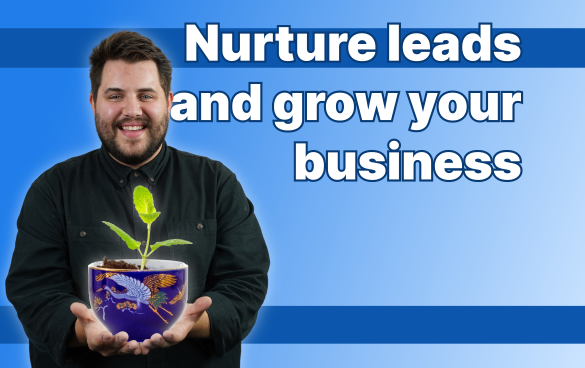-
 9 min. read
9 min. read
-
 Jessica Bonacci
Jessica Bonacci Multimedia Consultant
Multimedia Consultant
- Jessica is a Google Analytics-certified Multimedia Consultant at WebFX. She has created over 300 educational videos for the WebFX YouTube channel in the last five years, covering everything from the basics of digital marketing to more advanced data activation and AI usage. When she’s not researching and writing scripts, or bringing those scripts to life, Jessica manages the WebFX social media presence and engages with the WebFX audience. She specializes in video, content, and social media marketing but also loves SEO and many other aspects of digital marketing. When she’s not creating videos, Jessica enjoys photography, listening to music, reading, and catching up on the latest TV shows.
In this video, Alec from the WebFX Internet Marketing team has the scoop on how you can craft a lead nurturing strategy that works for your business.
Transcript:
On average, it’s said that about half of the leads in a sales pipeline aren’t ready to make a purchase. But your business can use its lead nurturing strategy to turn more of these undecided shoppers into loyal customers.
Think of nurturing your leads as you would growing a plant.
If you plant a seed in a random patch of dirt and forget about it, chances are it won’t become the beautiful flower you were hoping for. Now, if you plant the seed in nutrient-rich soil and water it regularly, you’ll probably end up with a flourishing plant. The same goes for your customers.
Forgetting about your leads, not answering their questions, and not grabbing their attention with regular content will probably get you a less-than-satisfying conversion rate — a.k.a. the rate at which people who interact with your business take a desired action.
If you follow up with leads, communicate with them on a regular basis, and create content that helps guide their purchase decisions, your relationship with your leads will bloom (pun intended) and you’re more likely to gain new customers.
This video will help you earn your green thumb in lead nurturing and give you some tips for creating a lead nurturing campaign that generates more revenue for your business.
What is lead nurturing?
A lead is someone who has engaged with your business in one way or another. They’ve shown signs that they’re interested in what you offer, whether they’ve contacted you or signed up for your emails, but they haven’t made a purchase just yet.
Lead nurturing means forming relationships with your leads, so you can guide them from being aware of your business to becoming paying customers. The overall goal of lead nurturing marketing is for your business to be present at each step of your lead’s buying journey, so you’re the business they choose when they’ve decided to invest their hard-earned money.
What is the customer buying journey?
The customer buying journey is just a way of identifying people’s intentions when they’re ready to make a purchase.
We can look at the buying journey as a marketing funnel (or sales funnel, if you’d prefer). At the top of the funnel, where it’s the widest, people are just getting familiar with your business, and likely, your competitors. They may have general questions about the services or products they’re looking for, or they might not know exactly what they need at this point.
The next part of your lead nurturing strategy focuses on the middle of the funnel. Things start to get a bit narrow here as people get a better idea of their needs but are still considering who can provide the best solution.
At the bottom of the funnel, where the cone is super narrow, we have people who are ready to make a decision. They’ve researched different products, services, companies, pricing, and everything in between, so they have a pretty good idea of who they trust with their investment.
People might not take a linear path and may revisit different stages as they research, but they’ll generally go through these phases until they make a purchase.
A lead nurturing campaign helps your business meet people wherever they’re at in their research so, again, they think of your business when they’re finally ready to buy.
You can reach leads at every stage of your digital marketing strategy with a mix of tactics you might already use, like content marketing and email marketing.
I’ll dive deeper into these strategies in the next section of this video.
5 lead nurturing strategy tips
1. Segment leads based on their needs
Not all leads are the same. Let’s say you manage a sports complex that offers lessons and leagues of all kinds. An adult who has signed up for information about your basketball leagues and only your basketball leagues probably wouldn’t like to be bombarded with ads for hockey lessons.
The same goes for people in different stages of the sales funnel. People who contact your business for a quote aren’t usually in the same mindset as people who signed up for your blog newsletter.
Create segments of your audience by using their similar characteristics, whether that’s the action they’ve taken on your site or their interests. Targeting the right people with the right content increases the likelihood they’ll become leads and, later on, customers.
2. Create content for people in all purchase stages
Again, people at different stages in their buying journeys want different types of information. Your lead nurturing strategy should include creating content for each phase of the sales funnel.
At the top of the funnel, when people are still figuring out what they want from a business, it’s your job to educate them. Answer their questions about your industry, your business, and whatever they’re looking to purchase.
In the middle of the funnel, your content should help people figure out the best company, product, or service for their needs. At the bottom of the funnel, whatever you create should gently guide people to your business. They know what they want from a company, and they just need one little nudge to get them to purchase.
Say you’re an accountant. Here’s an example of some content you might create for your funnel:
TOFU:
- A guide outlining what accountants do for customers
- A video overview of the materials people need to do their taxes
MOFU:
- A website page with tips for choosing the right accountant
- A calculator for the cost of tax prep
BOFU:
- An infographic explaining how your firm is different from everyone else’s (which is also helpful for people in the middle of the funnel)
- A collection of video testimonials from satisfied customers
The content topics in the example start in a pretty general way, answering questions and keeping things educational. As you approach the bottom of the funnel, your content becomes more focused on driving sales.
3. Follow up with leads quickly
Studies suggest that if you reach out to leads within five minutes of them contacting you, they’re 90% more likely to convert. That’s a lot of back and forth, and a lot of time that you or your sales team might not have available. But you don’t have to reach out to every lead manually.
Automated lead nurturing can change the game for you.
A marketing automation tool, such as our very own RevenueCloudFX, can help you track leads, send automated messages, and get more people to the final purchase stages of the marketing funnel.
Say it’s tax season, and you have a calculator on your website for how much someone’s tax prep will cost if they hire you. You also use automated lead nurturing.
To use your calculator, people have to give you their email. When they enter their email into your tool, they get added to an email campaign that sends them more information about tax prep, case studies from your business, and testimonials from satisfied customers.
By setting up automation, you’ve just taken a lot of work off of your plate and created an effective strategy for earning more customers.
4. Use multiple channels to reach your leads
Over 70% of Americans use at least one social media site. In addition, about 90% of Americans over the age of 15 use email. Also, I can’t skip this fact. Over 75% of people on the Internet read blogs.
People don’t exist on one digital platform anymore. It’s actually pretty common for people to have multiple email accounts, a number of different social media accounts, subscribe to several email newsletters, and read many blogs.
Because people interact with businesses in many different ways, your lead nurturing campaign should target more than one channel.
Creating content for your website is so important. And you can turn plenty of leads into customers with your emails. But don’t neglect social media for lead generation.
I guess the most important thing to remember is that your business needs to be wherever your potential leads are. You don’t have to spread yourself thin and be everywhere.
For a better understanding of which channels work best for you, take a look at whatever analytics platform you use (if you use one) and see where your leads come from.
Using a customer relationship management software (CRM) like our Nutshell, you can even filter your leads by what channel brought them to your website.
5. Personalize your content
Have you ever received a marketing email that uses your name, or landed on a website that seemed like it was created just for your needs?
Personalization can make your marketing efforts feel much more special and can help capture more leads. Seriously, though. 77% of customers are willing to choose, recommend, or pay more if a business creates a personalized experience. Personalization also increases the positive perception customers have of your business.
You don’t need to manually personalize every part of your lead nurturing strategy, however. You can save time with, yes, marketing automation.
If you have a guide about knitting and ask for people’s emails before giving them access, it’s not a bad idea to send your readers emails about the yarn you sell, or classes you offer.
If people from different industries visit a certain landing page on your website, you can dynamically adjust certain elements of that landing page for each industry.
You have plenty of room to get creative with personalization.
In fact, you have plenty of room to get creative with all of your lead nurturing. Test out different strategies. You might find that something I didn’t mention works for you. Let us know what strategies you’ve tested out in the comments!
Don’t forget to hit the subscribe button and the bell, so you don’t miss out on our latest videos. Plus, sign up for our email newsletter, Revenue Weekly, to get the latest digital marketing advice.
See you later, lead driver!
-
 Jessica is a Google Analytics-certified Multimedia Consultant at WebFX. She has created over 300 educational videos for the WebFX YouTube channel in the last five years, covering everything from the basics of digital marketing to more advanced data activation and AI usage. When she’s not researching and writing scripts, or bringing those scripts to life, Jessica manages the WebFX social media presence and engages with the WebFX audience. She specializes in video, content, and social media marketing but also loves SEO and many other aspects of digital marketing. When she’s not creating videos, Jessica enjoys photography, listening to music, reading, and catching up on the latest TV shows.
Jessica is a Google Analytics-certified Multimedia Consultant at WebFX. She has created over 300 educational videos for the WebFX YouTube channel in the last five years, covering everything from the basics of digital marketing to more advanced data activation and AI usage. When she’s not researching and writing scripts, or bringing those scripts to life, Jessica manages the WebFX social media presence and engages with the WebFX audience. She specializes in video, content, and social media marketing but also loves SEO and many other aspects of digital marketing. When she’s not creating videos, Jessica enjoys photography, listening to music, reading, and catching up on the latest TV shows. -

WebFX is a full-service marketing agency with 1,100+ client reviews and a 4.9-star rating on Clutch! Find out how our expert team and revenue-accelerating tech can drive results for you! Learn more
Try our free Marketing Calculator
Craft a tailored online marketing strategy! Utilize our free Internet marketing calculator for a custom plan based on your location, reach, timeframe, and budget.
Plan Your Marketing Budget

Proven Marketing Strategies

Proven Marketing Strategies
Try our free Marketing Calculator
Craft a tailored online marketing strategy! Utilize our free Internet marketing calculator for a custom plan based on your location, reach, timeframe, and budget.
Plan Your Marketing Budget





